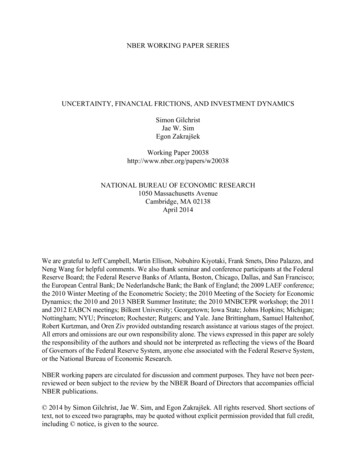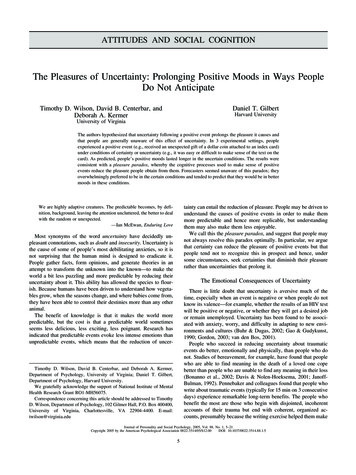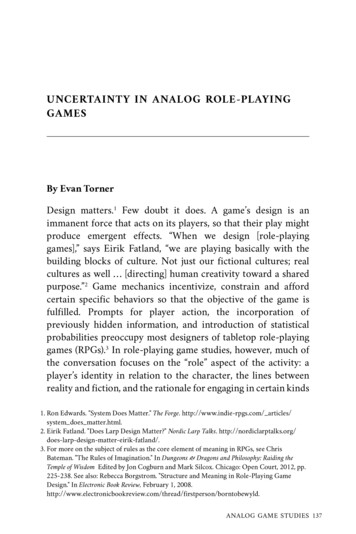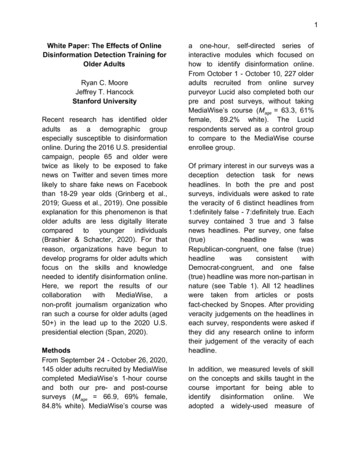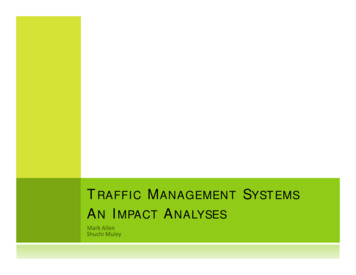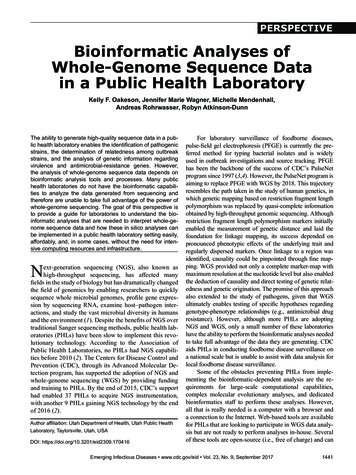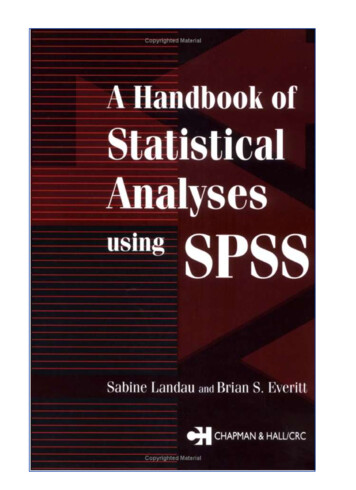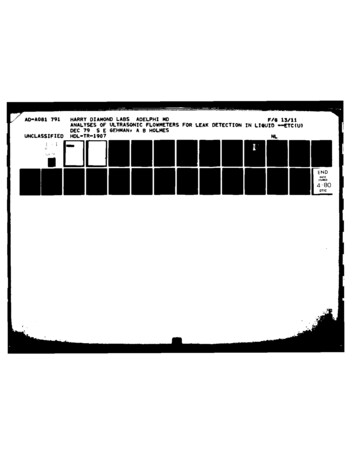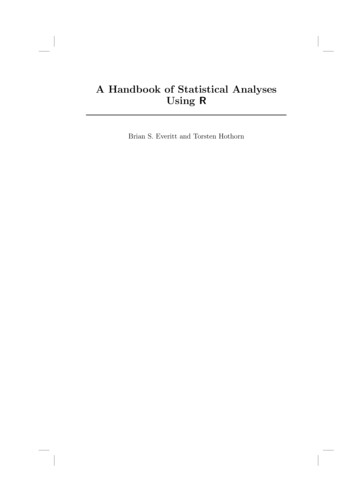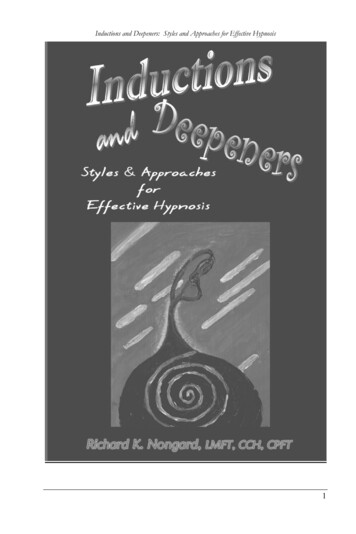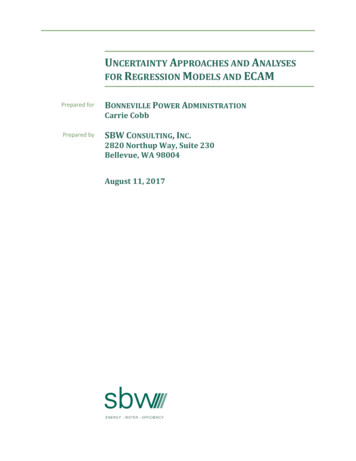
Transcription
UNCERTAINTY APPROACHES AND ANALYSESFOR REGRESSION MODELS AND ECAMPrepared forBONNEVILLE POWER ADMINISTRATIONCarrie CobbPrepared bySBW CONSULTING, INC.2820 Northup Way, Suite 230Bellevue, WA 98004August 11, 2017
Uncertainty Approaches and Analyses for Regression Models and ECAMTABLE OF CONTENTS1. EXECUTIVE SUMMARY .11.1. Reason for the Work. 11.2. Summary of the Work . 11.3. Author’s Comment . 22. BACKGROUND AND LITERATURE REVIEW.42.1. Foundations of Models and Uncertainty . 42.1.1. Confidence and Prediction Intervals for Ordinary Least Squares Regressions . 42.1.1.1. Confidence Level. 52.1.1.2. Confidence Interval . 52.1.1.3. Prediction Interval . 72.1.1.4. Putting it All Together . 92.1.1.5. Equations for Confidence and Prediction Intervals . 122.2. Challenge in Estimating Savings Uncertainty .132.3. Literature Review .132.3.1. ASHRAE Guideline 14-2014, Measurement and Verification of Energy, Demand,and Water Savings . 132.3.2. Uncertainty of “Measured” Energy Savings from Statistical Baseline Models,HVAC&R Research, January 2000. T. Agami Reddy, Ph.D. and David E. Claridge, Ph.D. . 142.3.3. Analysis and Improvement on the Estimation of Building Energy SavingsUncertainty, ASHRAE preprint provided by the author, 2012. Yifu Sun and JuanCarlos Baltazar, Ph.D. . 152.3.4. International Performance Measurement and Verification Protocol Volume 1. 152.3.5. FEMP M&V Guidelines: Measurement and Verification for Performance-BasedContracts Version 4.0 . 162.3.6. Regression for M&V: Reference Guide, Bonneville Power Administration, 2012. . 162.3.7. Verification by Energy Modeling Protocol, Bonneville Power Administration,2012. 172.3.8. Applied Data Analysis and Modeling for Energy Engineers and Scientists,Springer (2011). T. Agami Reddy. 172.3.9. Bayesian Analysis of Savings from Retrofit Projects, found on the web. Paperwas to be published in ASHRAE Transactions, Volume 118, Part 2. 2012. JohnShonder and Piljae IM. . 172.3.10. Notes and Memos . 182.3.11. Other Published Papers . 193. DESCRIPTION OF METHODS ANALYZED ·(UNCERTAINTY EQUATIONS AND CROSSCHECKS) . 203.1. ASHRAE Guideline 14 Equation .203.2. Improved Approach Based on Guideline 14 .213.3. Exact Formula for Ordinary Least Squares Regression .213.3.1. Derivation . 213.3.2. Discussion . 243.3.3. Handling Autocorrelation. 253.3.4. Development from Confidence and Prediction Interval Equations . 25iiSBW Consulting, Inc.
Uncertainty Approaches and Analyses for Regression Models and ECAM3.4. Bootstrap Approaches .263.4.1. Bootstrap Approach Assuming All Values are Independent. 293.4.1.1. Data Set. 293.4.1.2. Bootstrap Process . 303.4.2. Block Bootstrap Approach for Autocorrelated Residuals . 343.4.3. Bootstrap Approach for Data With a Relationship Between IndependentVariable Values . 364. RESULTS FOR EACH METHOD ANALYZED . 394.1. Results for Synthetic Data with a Linear Relationship and No Autocorrelation.394.1.1. Coefficients . 414.1.2. Uncertainty . 414.2. Results for Synthetic Data with a Linear Relationship and ModerateAutocorrelation .444.3. Results for Synthetic Data with a Linear Relationship, Higher Scatter andHigher Autocorrelation.464.4. Results for Real Data with a 4-Parameter Relationship, X-Values NotIndependent .475. CHOSEN APPROACH FOR UNCERTAINTY ESTIMATION IN ECAM . 496. RECOMMENDED FURTHER WORK . 50SBW Consulting, Inc.iii
Uncertainty Approaches and Analyses for Regression Models and ECAM1. EXECUTIVE SUMMARY1.1. Reason for the WorkThis report documents the development and testing of approaches to estimating theuncertainty of savings estimates based on regression models. Some of the approaches areapplicable to other types of data-driven models besides regression.The analysis of the various approaches was intended to confirm the validity of theimplementation of one particular approach implemented in the Energy Charting and Metricstool (ECAM). However, the analyses went further and estimated the validity or consistency ofthe various approaches tested. This report is intended to not only describe the ECAM approach,but also to make recommendations for further work, and to be educational in nature for anaudience not deeply-versed in the statistics of ordinary linear regression.This work is important in the context of changes in the energy efficiency industry. The relianceon whole building programs is increasing. Such programs include existing buildingcommissioning and building tune-ups, strategic energy management, and pay-for-performance.In all cases, it is desirable to not only have good estimates of energy savings, but to understandthe uncertainty in those estimates. It is also of increasing importance to credibly estimatedemand savings, whether from these same programs, or from demand response programs.1.2. Summary of the WorkFour data sets were analyzed for the uncertainty in aggregated predictions from regressionmodels. Such predictions allow the estimation of uncertainty in cumulative energy savings overa reporting period of multiple metering periods. These data sets can be summarized as follows:1. Synthetic data, linear relationship, no autocorrelation2. Synthetic data, linear relationship, moderate autocorrelation3. Synthetic data, linear relationship, higher scatter, higher autocorrelation4. Real data, 4-parameter relationship, X-values not independentThe first data set met all of the requirements for ordinary least squares linear regression, andwas used to check all of the methods.The analyses were performed using multiple methods. Four primary methods were used, withvariants for specific data sets.0.0.1. Algebraic solution for aggregated uncertainty from OLS regressions, based on a derivationfrom Josh Rushton, Ph.D. To handle data sets with autocorrelation, the equations weremodified using the ASHRAE FSU Approach to estimate an effective number of data points.2. ASHRAE FSU, from ASHRAE Guideline 143. Improved FSU, from Yifu Sun and Juan-Carlos Baltazar, Ph.D.SBW Consulting, Inc.1
Uncertainty Approaches and Analyses for Regression Models and ECAM4. Bootstrap Resamplinga. Resample Data X-Y Pairsb. Resample Residualsc. Resample Normal ResidualsThe results showed that the OLS approach, improved FSU, and Bootstrapping X-Y pairs providealmost identical results for a linear data set without autocorrelation. Their results matchregardless of the length of the reporting period. ASHRAE FSU is close, but deviates for reportingperiods less than or greater than about 6 to 7 months.For a data set with autocorrelation, it is well-known that not accounting for thatautocorrelation can greatly underestimate the uncertainty, and these results confirm that.Based on the results for the bootstrap, it appears that the ASHRAE adjustment to handleautocorrelation may significantly overstate its impact with daily data.For data where the X-values are related, such as energy models based on outside airtemperature, the approaches based on linear methods (OLS and FSU) appear to overestimatethe uncertainty. The OLS approach is close, but the Improved FSU approach overestimated theuncertainty by more than 30% for data set 4. Resampling residuals or normal residuals gavewhat are believed to be the best uncertainty estimates for data set 4, but the OLS approachprovided an estimate that was only 12% high.In the big picture, all of the approaches provided reasonable results. None of them were offfrom the others by an order of magnitude, or even a factor of two. The formulas for estimatinguncertainty based on OLS seemed to work fairly well even for data requiring a 4-parametermodel.The biggest issue appears to be for data sets with autocorrelation. The simple autocorrelationadjustment from ASHRAE is designed for models based on daily data. Hourly data has muchmore autocorrelation, and the autocorrelation may cover many lags—energy use may have acorrelation to not only the energy use one hour prior, but several hours prior, a day prior, andeven a week or more prior. Therefore, the algebraic approaches to estimating the impact ofautocorrelation should not be trusted if applied to hourly data.1.3. Author’s CommentBecause of these industry changes, there also seems to be increasing overlap betweenmeasurement and verification (M&V) and program impact evaluation. Credible site-specificM&V can ease evaluation burdens. However, the former is often the domain of energyengineers and analysts, who often lack significant statistical expertise. The latter is often thedomain of statisticians and economists, or other people with statistical expertise, but who lackengineering knowledge.In my opinion, it is valuable for both engineers and statisticians to learn from each other.Statisticians may find value in understanding how a measure might save energy, and how those2SBW Consulting, Inc.
Uncertainty Approaches and Analyses for Regression Models and ECAMprocesses might show up in an energy model. To maximize the benefits of regression and otherdata-driven models, I believe that they should usually have physical significance.Similarly, statistical knowledge can help engineers not only quantify energy savings, but alsoprovide early verification of performance of measures, identify when a site’s energy use ischanging, provide fault detection, and in some cases ev
11.08.2017 · ASHRAE FSU, from ASHRAE Guideline 14 3. Improved FSU, from Yifu Sun and Juan -Carlos Baltazar, Ph.D. 0.0. Uncertainty Approaches and Analyses for Regression Models and ECAM 2 SBW Consulting, Inc. 4. Bootstrap Resampling a. Resample Data X-Y Pairs b. Resample Residuals c. Resample Normal Residuals The results showed that the OLS approach, improved FSU, and
